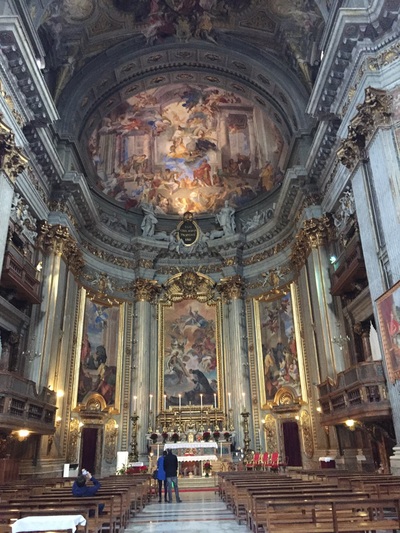|
The Sant’Ignazio Church is one of the most beautiful in all of Rome. Built in the 1600s for a Jesuit priest, Ignatius, the church is considered a “hidden gem” on Via del Caravita. Although the church looks plain on the outside (and I use that term loosely), the inside is breathtaking. The altar at the front of the church is enough to leave you awestruck with very intricate embellishments, gold accents, and colorful paintings. The ceiling is what really grabs your attention; with an incredible fresco embodies everything of the baroque time. According to Reids Italy, “Attention must be paid to the ceiling of the nave overhead. It is breathtakingly, dizzyingly, swimmingly decorated in a riotous, colroful, and amazingly masterful tromp l’oeil 1685 fresco depciting St. Ignatius and his Works by perhaps the greatest baroque master of perspective there ever was, Andrea Pozzo (who was himself a lay brother of the Jesuit order). The “dome” is another interesting aspect of this church. Andrea Pozzo, the artist of this fresco as well, painted a fake dome on the ceiling, lit with gold lights. This illusion, according Reids Italy, is only a copy of the real fresco, which was destroyed in 1891. The original is credited as being even more illusionary and inspiring. While I have only visited a few churches in the city so far, I have seen many in other cities (like Paris, London, Berlin, and Brussels), and I can honestly say this is my favorite. The church also graced The Guardian’s “10 of the Best Museums and Galleries in Rome” list from 2011. “The church of illusions. It was built between 1626 and 1650 and dedicated to Ignatius of Loyola. The first giant trick is Andrea Pozzo’s trompe l'oeil ceiling fresco which uses foreshortening to create an astoundingly realistic vision of the founder of the Society of Jesus soaring towards paradise to be welcomed by Christ (no, the Jesuits never were modest). A disk in the floor marks the ideal spot from which to experience the illusion. Further down the nave, another marker signals the best vantage point for a second bit of trickery. The Jesuits ran out of cash for the dome, so in 1685 Pozzo supplied them with a canvas depiction of what it might have looked like. Destroyed in 1891, the canvas was subsequently replaced.” (Read more here). When in Rome, this is a must-see sight, especially if you love baroque-style art and/or historical churches.
0 Comments
Leave a Reply. |
What we're looking at. Archives
September 2017
Categories |








 RSS Feed
RSS Feed
